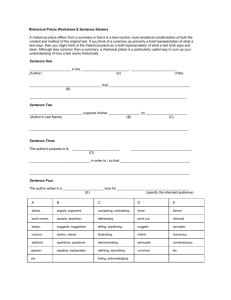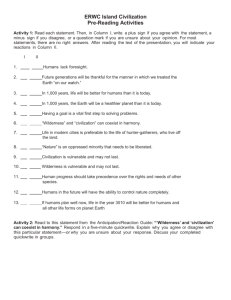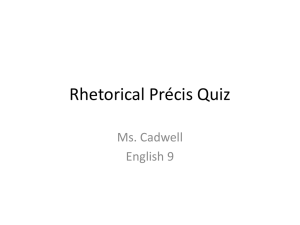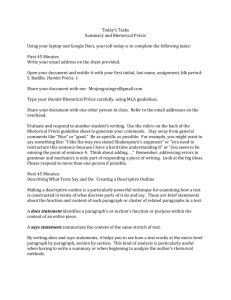What will civilization look like on planet Earth in the distant future?
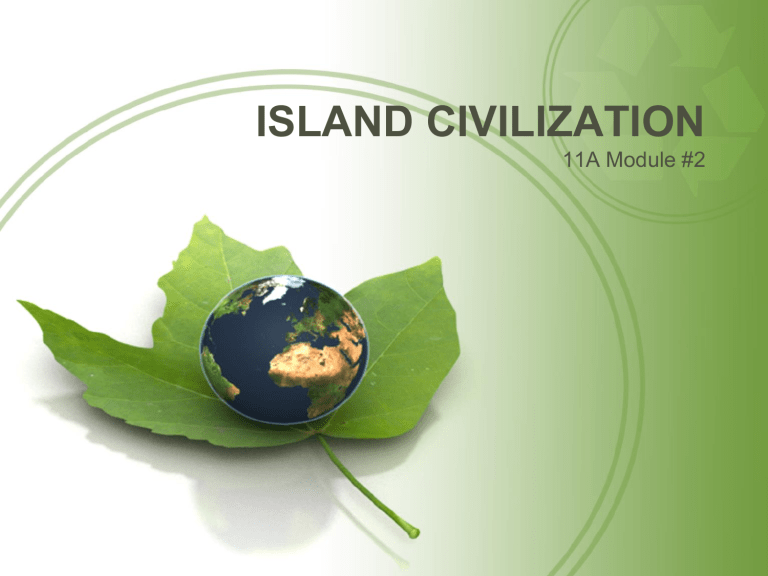
ISLAND CIVILIZATION
11A Module #2
Introduction to Module,
DAY1
ENTRY EVENT
This module asks you to consider the
“history and future of wilderness and civilization on planet Earth.”
Essential Question: What will civilization look like on planet Earth in the distant future?
Read each statement.
Then, in Column I, write a plus sign if you agree with the statement, a minus sign if you disagree, or a question mark if you are unsure about your opinion.
For most statements, there are no right answers.
Activity1
Agree= + Disagree= Don’t know=?
1.
I II
_____ _____ Humans lack foresight.
2. _____ _____ Future generations will be thankful for the manner in which we treated the Earth “on our watch.”
3. _____ _____ In 1,000 years, life will be better for humans than it is today.
4. _____ _____ In 1,000 years, the Earth will be a healthier planet than it is today.
5. _____ _____ Having a goal is a vital first step to solving problems.
6. _____ _____ “Wilderness” and “civilization” can coexist in harmony.
7. _____ _____ Life in modern cities is preferable to the life of huntergatherers, who live off the land.
8. _____ _____ “Nature” is an oppressed minority that needs to be liberated.
9. _____ _____ Civilization is vulnerable and may not last.
10.
_____ _____ Wilderness is vulnerable and may not last.
11.
_____ _____ Human progress should take precedence over the rights and needs of other species.
12.
_____ _____ Humans in the future will have the ability to control nature completely.
13. _____ _____ If humans plan well now, life in the year 3010 will be better for humans and all other life forms on planet
Earth
Activity 2- Survey the Text
Consider the following excerpts from the text:
“The new third millennium we are just entering affords an excellent opportunity to think big about the history and future of wilderness and civilization on planet Earth” (371, par. 1)
“As a historian I am concerned about how the future will regard what happened to the planet on our watch.” (372, par. 1)
Activity 2- Survey the Text
Consider the following excerpts from the text:
“What could the human tenure on Earth be like a thousand years from now —at the start of the
Fourth Millennium? My proposal involves some really major changes. I expect it to be controversial.” (372, par. 2)
“As a starting point, let’s consider wilderness. It’s a state of mind, a perception, rather than a geographical reality, and prior to the advent of herding and agriculture about ten thousand years before the present, it didn’t exist.” (372, par. 3)
Activity 3- Reading with the
Grain
• Chart the text
• Highlight sentences that have key words from vocabulary cards
• Partner-Pass-Read paragraphs 1-4
Homework
• Read Chief Seattle’s Speech
– Answer the reading questions
(full sentences with examples from the text)
– Rhetorical Précis
– Reflection summary
“How does Chief Seattle discuss wilderness & civilization”?
• Vocabulary Crossword (use your notecards)
• WHY? By the end of the week, you will produce an annotated bibliography about environmentalism
Homework
• Read excerpt from
“Walden” by Henry David
Thoreau
**Check out an 11 th grade textbook**
– Pages 382- 386 (Don’t go past the title ‘Solitude’)
– Write a Rhetorical Précis of
Thoreau’s experiences in nature
– Sentence Pattern 6 practice
DAY 2
Activity 4- Reading with the
Grain
• Chart the text
• Highlight sentences that have key words from vocabulary cards
• Partner-Pass-Read paragraphs 5-8
• When you finish : Complete a SOAPStone summary of paragraphs 1-8
SOAPStone Summary
Activity 5: 5 Word Summary
Homework
• Read excerpt from
“Silent Spring” by
Rachel Carson
– Write a Rhetorical Précis of
Carson’s excerpt
– Answer Questions
DAY 3
Activity 6- Loaded
Language
• Read paragraphs 9-14
• Complete Says / Does
• Highlight examples of “loaded language”
– Extreme feelings, either negative or positive
– Words with bias and tone
– Words that are used figuratively to show opinion
Activity 6- Loaded
Language
• Example:
Activity 6- Loaded
Language
• Make a chart like the one below.
• Find 5 examples of loaded language
– Describe their connotation
– Offer neutral and substitute words
Activity 7: Allusions
Activity 7: Allusions &
References
• Underline all the allusions you can find in paragraphs 9-14.
• What kinds of allusions does Nash make in paragraphs 9-14?
• How do these allusions make him more credible?
• Why does he use these allusions? What claim is he supporting?
Homework
• Find an article on the environment.
– Write a Rhetorical
Précis of it
DAY 4
Read para. 15-29
• Complete SAYS / DOES
• Underline the different scenarios that Nash proposes for the future
Activity 8 – Different Perspectives
Activity 8 – Different Perspectives
Activity 8 – Different Perspectives
Homework
• Write a rhetorical précis of Nash’s article.
• Focus on covering the whole article.
DAY 5
Dialectical Journal
Homework
• Create a visual interpretation of each of
N ash’s 4 scenarios . For each visual, add one direct quote from the text that supports your picture.
• Choose a prompt . Each prompt is tied to a rhetorical mode. Write an essay that answers the prompt.
DAY 5
Activity 9 Quick-write
• “Wilderness and civilization can co-exist in harmony.”
• Agree or disagree
• Come up with specific examples to support your opinion
Preparing to Write
• Choice of Prompts:
1. Write an argumentative letter to Nash
2. Write an argumentative essay about which scenario is likely to happen and why
3. Write an argumentative essay that proposes a scenario of your own
Activity 10: Entering the
Discussion
• Is humanity doomed?
• Is the Earth doomed?
• What will civilization look like in the future?
• Are humans selfish?
Activity 10:
Activity 10:
Thesis Writing
• Using Sentence Pattern 8
• Using Sentence Pattern 1c
• Using Sentence Pattern 11 and 11a
DAY 6
Timed Write
Revisions to essay & Annotated Bibliography
DAY 6
Annotated Bibliography
• Type your Précis statements into an annotated bibliography
• Thoreau
• Carson
• Chief Seattle
• Nash
• Article of Choice
